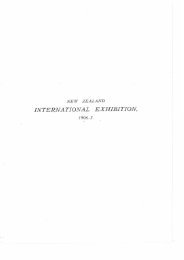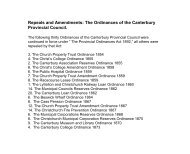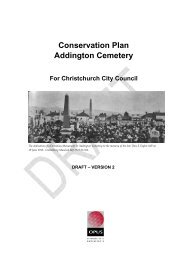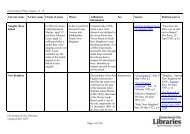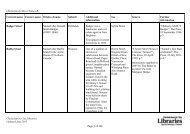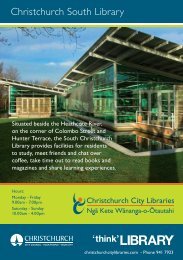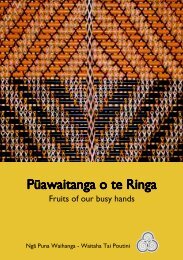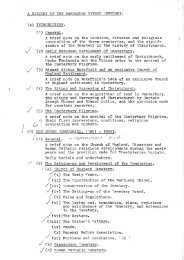Rich man, poor man, environmentalist, thief - Christchurch City ...
Rich man, poor man, environmentalist, thief - Christchurch City ...
Rich man, poor man, environmentalist, thief - Christchurch City ...
Create successful ePaper yourself
Turn your PDF publications into a flip-book with our unique Google optimized e-Paper software.
<strong>Rich</strong>ard’s men strove to<br />
turn into reality the ideal<br />
of ‘making <strong>Christchurch</strong><br />
beautiful’. They worked<br />
in the vicinity of Avon<br />
bridges within the city<br />
and, at Colombo Street,<br />
replaced decayed<br />
structures with shrubs, a<br />
miniature waterfall and<br />
steps which gave access to<br />
the river.<br />
‘<br />
’<br />
46<br />
for the most artistic garden as seen from the street. <strong>Rich</strong>ard<br />
looked wistfully to the time when <strong>Christchurch</strong> would realise<br />
‘what a great cash asset there is in civic beauty’.<br />
<strong>Rich</strong>ard was active in other beautifying projects. Justice<br />
Department officials allowed him to convert into a flowerbegirt<br />
fountain an artesian spring near the court buildings.<br />
<strong>Rich</strong>ard told Charles Chilton: ‘This is making quite a nice<br />
little display and interesting <strong>man</strong>y people’. Just upstream were<br />
the provincial council buildings which the government<br />
returned to local control in 1928. <strong>Rich</strong>ard sought to keep the<br />
city council from infiltrating into the Gothic masterpiece and<br />
perhaps blotting the extensive river banks with ill-considered<br />
extensions. He encouraged tree-planting in the grounds and<br />
added the ‘bright array of flowers and verdant lawn’ which<br />
make up the rock work garden about the Armagh and Durham<br />
Street section of the complex. Then, in 1934, the elderly R E<br />
Green came forward with his statue of Canterbury’s first<br />
Superintendent, James Edward FitzGerald. <strong>Rich</strong>ard was eager<br />
that the association accept a structure which the city council<br />
had declined and have it erected on the provincial council<br />
lawn. The association executive failed to appreciate that this<br />
was a tainted gift – the Greens were accusing their father of<br />
divesting himself of his assets so that there would be little left<br />
for those who had a claim against his estate. In 1939, after<br />
Green had died and <strong>Rich</strong>ard curtailed his public activities, the<br />
statue was erected on <strong>Christchurch</strong> Domains Board land on<br />
the periphery of the Botanic Gardens opposite Cashel Street.<br />
Although <strong>Rich</strong>ard worked with other committee members –<br />
and transcended their parochialism by establishing the<br />
Canterbury Roadside Beautifying Association – his particular<br />
interest was the improvement of the Avon River and its environs.<br />
The town of his birth had the Severn on three sides; his father’s<br />
business was water-powered. He enthused about the weirs and<br />
locks of the well-<strong>man</strong>aged English boating rivers and admitted<br />
that ‘a delusion and a snare’ had brought him to <strong>Christchurch</strong> –<br />
a booklet containing a picture of a four-oared boat on the Avon.<br />
On arrival, he scanned the river but could not find the vessel.<br />
Soon after World War I, <strong>Rich</strong>ard imported a canoe from<br />
Canada. At the bottom of Rossall Street, he launched the craft,<br />
and, with the help of a member of his staff, paddled it to<br />
Pleasant Point, a recently developed picnic site on the lower<br />
Avon. There the Owen family spent several Christmases<br />
under canvas.<br />
In the area where <strong>Rich</strong>ard launched his boat there was a<br />
one acre wilderness bounded by a 10 foot iron fence. This<br />
adjoined and was usually thought part of the property of the<br />
Helmore family. On searching the title, however, <strong>Rich</strong>ard<br />
found that, in 1917, it had become public land. With the<br />
approval of the Waimairi County Council, he set to work,<br />
cleared the undergrowth, and, as he did so often, spent his<br />
own money on a project which was for the public good.<br />
Beautifying Association luminary Charles Chilton opened<br />
Millbrook Reserve to the masses on 26 January 1924. Four<br />
years later a photographer, Carl Beken, presented <strong>Rich</strong>ard<br />
with an album which showed how the area had been developed<br />
from ‘little more than a rubbish dump’ to ‘one of the city’s<br />
most attractive beauty spots’.<br />
When, in 1922, the ‘Creeping Depression’ came to<br />
<strong>Christchurch</strong>, <strong>Rich</strong>ard established the River Improvement<br />
Fund. Business people and local government gave money, and<br />
men employed on public works were paid not a pittance but<br />
the award rate, a principle being established to which the city<br />
council would adhere even in the depths of the 1930s’<br />
Depression. The committee was to the fore when distress<br />
returned in 1926, eventually becoming the River Improvement<br />
and Unemployment Fund. <strong>Rich</strong>ard also organised the<br />
Citizens’ Unemployment Committee which collected money<br />
and provided work. At depots, the committee gave relief<br />
rations to those for whom work could not be found. At<br />
workers’ meetings <strong>Rich</strong>ard learned of the men’s needs. His<br />
middle class biases showed through only on the subject of<br />
communism. At Trades Hall he thought he was ‘in Russia<br />
for an hour or so’ when he found Sidney Fournier distributing<br />
goods to the needy – ‘dishing out bread and jam… and making



